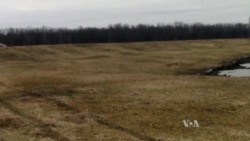A three-kilometer long wall of earth, 23 meters wide and as high as three and a half meters, could be all that stands between the Great Lakes and an invasion of Asian Carp.
The berm runs through Eagle Marsh, in the midwestern state of Indiana. During large floods, the 290-hectare wetland drains into the Great Lakes. And that's the problem the berm was designed to address, says Betsy Yankowiak, Director of the Little River Wetlands Project.
"Basically a whole bunch of federal stakeholders and state stakeholders and members in our community came together to try to figure out a way to separate the basins, to stop the carp that’s exotic from Asia moving into Lake Erie."
Asian carp escaped from fish ponds in Arkansas in 1975 and quickly spread to 23 states, up and down the Mississippi River and its tributaries. They are already in the Wabash River, which flows into Eagle Marsh. The silver fish, which easily grow to the size of house cats, jump out of the water when they're startled, flying into boats often injuring people and damaging equipment.
During heavy rainfall or rapid snow melt, the marsh connects the Wabash to the Maumee River, which in turn empties into Lake Erie. Because all the Great Lakes are connected to each other, Yankowiak says allowing the invasive species access to the additional waterways is disastrous for the entire ecosystem.
"They’re voracious eaters. They eat the microscopic organisms like plankton in our river systems and lakes."
That prevents native species from having enough resources to survive.
The berm will ultimately prevent the carp and more than 200 other invasive species from entering the Great Lakes, where they could wreck havoc on everything from the barge industry to commercial fishing.
A barrier in a bog
Initially, a moveable chain link fence that could be closed during flooding was installed as a stopgap. But USDA engineer Duane Riethman, with the Natural Resources Conservation Service, who designed the berm, says they knew something more had to be done. While the $3.5 million project had a great deal of support from federal, state, and local agencies, he says there were some large physical obstacles to overcome.
"First and foremost, it was working in a marsh. We had restored it as a wetland and it was now moving a large volume of dirt into basically a marsh."
Because the wetlands act as a basin for runoff water, the project was further complicated by the wettest spring in recorded Indiana history. It looked as if the berm might never get built because it was simply too muddy.
"But then," Riethman added, "as the summer progressed and turned into fall, things turned out quite dry and made things very good for us to work." So good, that the project actually finished ahead of schedule!
State conservation agents and Little River Wetlands Project will now maintain the site. "So we will keep it mowed and then check it for burrowing animals to make sure no groundhogs or anything are causing problems with the berm," Yankowiak explained.
Completion of the project doesn’t just keep certain species out, it also restores some animals that are either endangered or facing endangerment such as Blandings Turtles, salamanders, and snakes. And it acts a refuge on the migratory path for several species of birds and Monarch butterflies.
The final steps of the project include adding a walking path on top of the berm and planting more native vegetation, both of which will be competed this spring.







